The Conquest Of Tarifa, Spain
By Robin Graham
In the year 711, Tariq Ibn Ziyad — a Berber general — landed near the southern tip of Spain with 7,000 men, at the burning edge of the wildfire that was the Arab Empire — the House of Islam. In just a few years they were to conquer almost all of Spain, bringing much of the Iberian peninsula under Arab and Islamic rule for the next seven centuries and leading to the establishment of a Caliphate that would nurture a cultural milieu more diverse and sophisticated than the rest of Europe could hope to compete with until the blossoming of the Enlightenment, hundreds of years later.
None of which seems very important right now as I totter down Calle Nuestra Senora de la Luz and lurch into tiny San Hiscio square; I have had a few beers and I am very, very hungry. I take a table and ask the camarero to bring me some chocos, or cuttlefish, and another beer.
It is night and the sky is black, the buildings white, the air balmy. The old town is a maze of narrow cobbled streets and lanes, most of them on a slope. Wandering along one can peek though the Arab-style double doorways and catch a glimpse of the verdant, lovingly tended courtyards within. It brings to mind the famous pueblos blancos of the southern mountains, or the Albayzin in Granada, and exudes the ramshackle elegance that only an old Spanish town can deliver. This little square is an object lesson in the antique aesthetic of Andalusia, except for a beautiful modernist cinema I can’t help staring at.
Scholars tend to agree these days that the Arab conquest of Spain was a substantially peaceful affair, relatively speaking. Spaniards were already suffering plenty under the Visigoth yoke and were, in particular the Spanish Jews, perfectly open minded about the potential benefits of Arab rule. Just about anything was better than what they had and many of them intercepted the advancing Moorish army, not to fight them but to swell their ranks and lend a hand. Still, relatively speaking is the operative phrase; these were brutal times and one can imagine that there was a certain amount of fuss — pushing, shoving and yes, perhaps even some outbreaks of running and screaming.
 Not in this town though, I’ll wager. The reaction here would have been markedly different. Because — although the year 711 is held up so often, and so iconically, as the year the Moors came to Spain — these people had seen it all before. They were all screamed out. As the events of that year unfolded they might even have been spotted stifling their yawns because a year earlier, in the now largely forgotten 710, another Berber called Tarif Ibn Malluk had landed here with a force around 500 strong.
Not in this town though, I’ll wager. The reaction here would have been markedly different. Because — although the year 711 is held up so often, and so iconically, as the year the Moors came to Spain — these people had seen it all before. They were all screamed out. As the events of that year unfolded they might even have been spotted stifling their yawns because a year earlier, in the now largely forgotten 710, another Berber called Tarif Ibn Malluk had landed here with a force around 500 strong.
He was sent by Tariq to test the waters and having taken the town and sortied as far as Algeciras, encountering little or no resistance, he returned across the straits with booty and captives, convincing Ibn Ziyad that an invasion of the Iberian peninsula was within his reach. This place then was the litmus test. The Arabs named it the Isle of Tarif after the leader of the advance party and it bears his name to this day.
This is Tarifa.
The chocos are excellent. Cuttlefish, if you didn’t know, aren’t fish, they are closely related to squid and are served in all sorts of ways but I’m having them in a light batter, calamares-style. Indeed, anything that comes from the sea is good in Tarifa, unsurprising for a town that until around 25 years ago had been little more than a fishing village for centuries.
Its destiny has been inextricably tied to the sea since its Phoenician beginnings. The Arabs considered it the key to Spain, fortifying it to maintain their hold over the Straits. Its strategic position was the spur for the subsequent wrestling match between Christian and Moor that culminated in its final conquest by Sancho IV of Castile in 1292.
If the sea was the only factor governing Tarifa’s fate it might have remained a fishing village, but it isn’t. This is probably the windiest place on the continent, and Tarifa is renowned as Europe’s wind capital. It has two of them, for those that are interested: the Levante which comes from the east, and the Poniente from the west. It is this combination of wind and wave that led to the latest invasion in Tarifa’s long line of them, and to the siege which to this day maintains its grip on the town.
If strapping your feet to a board, your body to a kite, and launching yourself off Europe’s windiest coast seems like a stupid idea to you, then: a) you have a bright future ahead of you my friend; and, b) it probably won’t be in Tarifa. Tourism has become the town’s main source of income over the last 20 years or so but it is tourism of a very particular kind: a walk along the main commercial street throws up names like O’Neill, Quicksilver, Animal and Billabong alongside local brands Tarifa Pirates, Hot Stick and Cat Fun. Several surf clothing labels have been launched here in fact, later going national and even international.
Amidst the tapas bars and mesons that you would expect to find in an Andalusian town and that are, thank goodness, still here, you will find trendy chill-out joints — blue lit, branded, soundtracked with house and jazz and wi-fi enabled. For your breakfast, as well as a tostada or a croissant you can have muesli, fruit juices and smoothies, egg-white omelets and vegetarian, macrobiotic whatevers. In the summer months — all six of them — the troops that led this latest incursion are everywhere, the uniform a messy head of sun bleached hair, a nonchalant air, worn but meticulously selected surf clothing and a ridiculous, ridiculous tan.
Residents of nearby Algeciras — a salty port city — refer to Tarifa contemptuously as a tourist town and yet, unfairly, are just as dismissive of its quieter winter months — all one-and-a-half of them — when apparently, “there is nothing there.” Neither is true. It is a scene town, so far unspoiled by the altogether different trappings of uncontrolled, rampant tourism. You can find that on the Costa del Sol but not here, not yet. No lager louts, no vomit in the streets, no excruciating resort style entertainments.
 Where Tarif got as far as Algeciras, these new invaders sortie westwards, spreading out along the Atlantic (that’s another thing: situated as it is on the Straits, in Tarifa you can take a dip in the Mediterranean and, just minutes and a lazy stroll later, in the Atlantic). A number of beaches line up along this windswept coast. Long, white Los Lances with its fine sand is reserved for bathers in the busy months, kite and windsurfers off-season. Its northern stretch is unspoiled and is a bird sanctuary. Further on is Valdevaqueros, epicenter of all things kitesurf and described in a local guide, without a trace of irony, as for “cool people.” The championships are held here. It is in fact a fairly aggressive mess of boards, kites and people. I avoid it.
Where Tarif got as far as Algeciras, these new invaders sortie westwards, spreading out along the Atlantic (that’s another thing: situated as it is on the Straits, in Tarifa you can take a dip in the Mediterranean and, just minutes and a lazy stroll later, in the Atlantic). A number of beaches line up along this windswept coast. Long, white Los Lances with its fine sand is reserved for bathers in the busy months, kite and windsurfers off-season. Its northern stretch is unspoiled and is a bird sanctuary. Further on is Valdevaqueros, epicenter of all things kitesurf and described in a local guide, without a trace of irony, as for “cool people.” The championships are held here. It is in fact a fairly aggressive mess of boards, kites and people. I avoid it.
Past that the relatively sheltered coves of Punta Paloma, much more me, and further again the beaches of Bolonia, Los Alemanes and Atlanterra. In places the urbanization of the area is at an advanced stage but so far this costa, the Costa de la Luz between Tarifa and Cadiz, has escaped the ravages of its neighbor, the Costa Del Sol. Testament to this is the fact that the majority of visitors here are Spanish.
As for the charge that there is nothing to Tarifa in the winter months — when the chill-out bars and designer boutiques close their doors and the surf battalions pull out — what is left is exactly what I came here for: a quiet Spanish pueblo with a rich history, steeped in Moorish tradition, battered by winds on a starkly beautiful dramatic coastline and, crucially, peppered with tiny plazas and tinier tapas bars serving up the best food, for my money, in the world.
When the town is “deserted” I will still be able to wander down to my favorites. El Pasillo, for instance, or Caxala, and tuck into the media racion or tapa of my choice, or indulge in one of my favorite pastimes: bullying my girlfriend into trying various types of seafood she has no interest in.
They talk of Tarifa in the winter with dread. All that wind, no tourists and only the locals and their tapas bars left. I can’t wait. I am an invader too. I’m not going anywhere for the time being and it isn’t until I have made it through those months that my conquest of this little town will be complete.

ABOUT THE AUTHOR
 Robin Graham has written for In Madrid, The Expeditioner and the Matador Network. He regularly contributes to The Spain Scoop and blogs at the award-winning Alotofwind. Follow him on Twitter: @robinjgraham.
Robin Graham has written for In Madrid, The Expeditioner and the Matador Network. He regularly contributes to The Spain Scoop and blogs at the award-winning Alotofwind. Follow him on Twitter: @robinjgraham.

